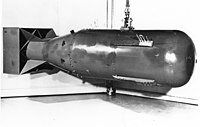
Photo from wikipedia
ABSTRACT The net radiation obtained by the earth’s surface drives the exchange and transmission of energy and material in earth systems. Accurately quantifying the surface net radiation (SNR) is a… Click to show full abstract
ABSTRACT The net radiation obtained by the earth’s surface drives the exchange and transmission of energy and material in earth systems. Accurately quantifying the surface net radiation (SNR) is a premise for climate change research. Satellite remote-sensing data can provide land-surface information on a regional scale, making it possible to monitor SNR spatial patterns and changes using a cost-effective methodology that is superior to traditional ground observation. Furthermore, it can address the problem that the local-scale observational data does not extend to large areas with sparsely distributed meteorological observation sites. In this article, urban and suburban areas of Beijing were selected as study areas, and the surface physical parameters were retrieved based on Landsat images. Auxiliary data were also applied to model SNR, including Moderate Resolution Imaging Spectroradiometer (MODIS) images and other land-surface observational data obtained from meteorological stations. In addition, the SNR spatial patterns and their changes in urban and suburban areas and the differences in different land-surface types, different years, and different seasons were analysed. The results showed the following: (1) the fractional vegetation cover was one of the principal factors affecting the surface radiation process, and the SNR value was high where the cover value was high. Comparing the SNR in urban areas with that in suburban areas, the value was higher, and there was generally a ‘plateau’ in the spatial distribution characteristics in urban areas. (2) After analysis of the mean SNR value for different land-surface types, the highest mean SNR was for water, followed by vegetation cover, artificial surface and bare land, and the deviation of the mean SNR values of all of the land-surface types in winter was smaller compared with those in summer. (3) With urban sprawl and rapid changes of land-surface cover, there was an increasing trend in the SNR value in urban areas that was more significant in summer than that in winter. According to the SNR values in 2004 and 2014, the areas of all of the land-surface types showed a small increase of approximately 35 W m–2 in summer and 25 W m–2 in winter.
Journal Title: International Journal of Remote Sensing
Year Published: 2017
Link to full text (if available)
Share on Social Media: Sign Up to like & get
recommendations!